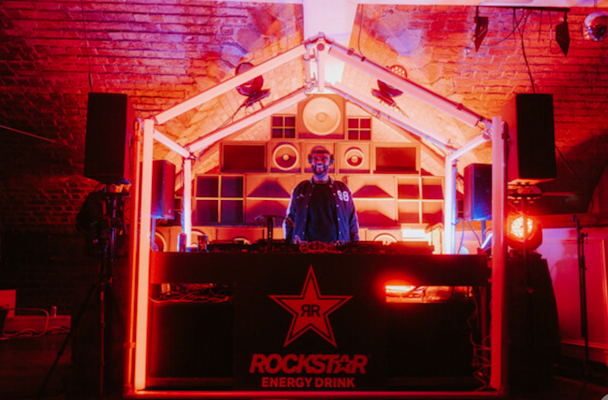Why events marketing spend is booming when other channels are sluggish
Event marketing is the standout category in the IPA’s new Bellwether report after showing nine consecutive quarters of ‘considerable’ growth. But what’s driving marketers to splash out on live events at a time when budgets are stretched?

Rockstar Energy Drink push into live music / Rockstar
Spend on experiential marketing is up as brands respond to consumers’ growing appetite for real-world experiences. But leaders at Snap, Eventbrite, PepsiCo and Live Nation tell us there is much more to this trend.
The quarterly temperature check of 300 UK marketers found that 32% had seen their event budget increase, compared with just 9% who had theirs cut, giving a net balance of +23% – up 16% on last quarter. Events easily had the healthiest growth compared with the other categories; direct marketing had the second biggest boost at 7% followed by sales at 5%. Conversely, main media advertising shrunk by 1%.
The IPA said the event budget boost was “considerable.” Not only is it the ninth successive quarter of growth but also the “strongest” quarterly increase that the survey has recorded in its 11-year history. Spending in the category is expected to continue into 2024 and 2025, with the report forecasting an annual uplift of 18.7% compared with the previous year.
Advertisement
What’s driving this trend?
Eventbrite is one of the main ticket sites brands are using to host events. Its chief marketing officer, Tamara Mendelson, believes the spending growth is a response to the oversaturation of online ads. “Online marketing has become incredibly crowded and competitive. This makes it difficult for brands to stage a memorable digital-only campaign,” she says.
Mendelson also suggested that too much screen time is a reason people crave real-life experiences. Interestingly, despite trying to escape their screens, many can’t seem to ditch them at events.
Eventbrite’s annual trends report recently found that 71% of 21-to-35-year-olds and 63% of all attendees share and post videos and images from their mobile at events. Catering to this, the report also found that wifi use at events has grown with 11% more attendees saying they have used it than the previous year.
“Experiential marketing events create highly memorable brand touch points for attendees and for their followers on social, amplifying the brand message far beyond the event itself and into the digital sphere,” says Mendelson.
Advertisement
One way brands have been blending physical and digital is through tie-ups with tech platforms like Snap, with the social app providing augmented reality mirrors at pop-ups with the likes of Asos, Vogue and the V&A.
Valentina Culatti, director of creative strategy and production EMEA at Snap says: “Events excel in enhancing brand visibility, allowing businesses to showcase their offerings in memorable, tangible ways, providing an avenue for immersive experiences that significantly amplify brand awareness.”
There is also the added benefit of collecting direct feedback from customers and for marketers to have face-to-face interactions, she says, as well as being “excellent for content creation” by providing materials that can be repurposed.
Several high-profile brands have made significant commitments to experiential marketing in the past year including Pinterest, Ladbrokes and Asos, with the latter adding £30m to its overall marketing spend to invest in experiential.
PepsiCo-owned energy drink Rockstar recently signed a significant deal with Live Nation to sponsor six British festivals, including Reading, Leeds and Wireless. Sarah Mahoney, marketing manager at PepsiCo, says live music is a central part of Rockstar’s strategy to build the brand’s reputation within the music industry. “We aim to show up in places and events our target Gen Z audience naturally enjoys, making a connection with Rockstar Energy Drink and assessing brand engagement as a measure of success,” she says.
Suggested newsletters for you
How will the event be worth the investment?
It’s worth noting that event budgets have grown at a time when CMOs are under increasing pressure to prove ROI, but events aren’t the easiest environment to measure. Marketers are using a combination of brand awareness metrics, attendee numbers and social engagement to define whether an event is a success.
Peter Aitken, head of customer strategy and insight at Kantar, says companies are increasingly asking the market research firm to measure an event’s impact on brand awareness. “They are looking at it asking: ‘Did we execute this event effectively? Has it made us feel like a differentiated brand, and did we get the opportunity to get across who we are and what we stand for?’” Aitken reveals.
Culatti adds that events should “encompass pre-event promotions, engaging content and effective post-event follow-ups so that you have access to as much measurement data as possible.”
Think beyond the event
The ticket site and entertainment company Live Nation is seeing an “uptick in curiosity” from marketers to engage with people throughout the “fan journey,” Jim Campling, president of Live Nation UK marketing partnerships, says. “Understanding the event cycles and the phase a particular fan is in can be crucial to making the right impression at the right time,” he advises marketers.
“To help brands, we’ve identified four phases across the live music fan journey – discover, plan, experience and relive.” For example, with a festival sponsorship, the brand would be incorporated into moments like the artist line-up, along with the build-up to the event comms and the playback content.
“If marketers focus on smart engagement and loyalty at live events and interact with the communities in creative ways, audiences will champion their brands for years to come,” says Campling.
On a “softer” note, Aitken adds that events are helping to invigorate marketing teams. “From a company perspective, it’s much more fun and enjoyable for the marketing team to get behind,” he says. “It’s great when you can get the team together to produce an event, it really does feel like a team activity.”

